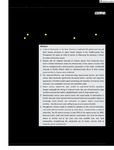Regular monitoring and targeted removals can control lionfish in Mediterranean Marine Protected Areas
| dc.contributor.author | Kleitou, Periklis | |
| dc.contributor.author | Rees, Sian | |
| dc.contributor.author | Cecconi, F | |
| dc.contributor.author | Kletou, D | |
| dc.contributor.author | Savva, I | |
| dc.contributor.author | Cai, LL | |
| dc.contributor.author | Hall‐Spencer, JM | |
| dc.date.accessioned | 2021-08-26T19:04:13Z | |
| dc.date.available | 2021-08-26T19:04:13Z | |
| dc.date.issued | 2021-07-12 | |
| dc.identifier.issn | 1052-7613 | |
| dc.identifier.issn | 1099-0755 | |
| dc.identifier.other | aqc.3669 | |
| dc.identifier.uri | http://hdl.handle.net/10026.1/17735 | |
| dc.description.abstract |
<jats:title>Abstract</jats:title><jats:p> <jats:list> <jats:list-item><jats:p>A lack of biosecurity in the Suez Canal has combined with global warming and other human pressures to cause abrupt changes in the Mediterranean Sea. Throughout this region an influx of species is influencing the outcome of efforts to protect and restore nature.</jats:p></jats:list-item> <jats:list-item><jats:p>Despite calls for targeted removals of invasive species from protected areas, there is limited information about the effectiveness of this course of action from both an ecological and a socio‐economic perspective. In this study, coordinated removals of lionfish (<jats:styled-content style="fixed-case"><jats:italic>Pterois miles</jats:italic></jats:styled-content>) by volunteers/scuba divers at three marine protected sites in Cyprus were conducted.</jats:p></jats:list-item> <jats:list-item><jats:p>The removal efficiency was monitored using visual‐census surveys and citizen science data. Removals significantly decreased lionfish numbers but long‐term suppression of lionfish would require monitoring and repetition of removals when necessary, since population recovery was sometimes rapid.</jats:p></jats:list-item> <jats:list-item><jats:p>Citizen science yielded the data needed to understand lionfish population changes and guide the timing of removal events, but was characterized by large variation and potential outliers, highlighting the need for large sample sizes.</jats:p></jats:list-item> <jats:list-item><jats:p>Questionnaire surveys were used to assess the social impact of participation in lionfish removals; these showed that involvement had a strong positive impact on knowledge about lionfish and motivation to support marine conservation activities – the divers were even willing to pay extra to remove lionfish.</jats:p></jats:list-item> <jats:list-item><jats:p>Management reforms would be needed to capitalize on this societal motivation, and enable effective lionfish removals by scuba divers, coordinated by competent authorities. The EU aims to protect at least 30% of the marine waters by 2030. Removal events could help shield selected conservation sites from the adverse effects of lionfish and at the same time help establish links with local communities, strengthening the sustainable use of marine systems both at corporate and at societal levels.</jats:p></jats:list-item> </jats:list></jats:p> | |
| dc.format.extent | 2870-2882 | |
| dc.language | en | |
| dc.language.iso | en | |
| dc.publisher | Wiley | |
| dc.subject | alien species | |
| dc.subject | citizen science | |
| dc.subject | climate change | |
| dc.subject | eradication | |
| dc.subject | invasive species | |
| dc.subject | management | |
| dc.subject | non-indigenous species | |
| dc.subject | Pterois | |
| dc.subject | Suez Canal | |
| dc.title | Regular monitoring and targeted removals can control lionfish in Mediterranean Marine Protected Areas | |
| dc.type | journal-article | |
| dc.type | Journal Article | |
| plymouth.author-url | https://www.webofscience.com/api/gateway?GWVersion=2&SrcApp=PARTNER_APP&SrcAuth=LinksAMR&KeyUT=WOS:000675256100001&DestLinkType=FullRecord&DestApp=ALL_WOS&UsrCustomerID=11bb513d99f797142bcfeffcc58ea008 | |
| plymouth.issue | 10 | |
| plymouth.volume | 31 | |
| plymouth.publication-status | Published | |
| plymouth.journal | Aquatic Conservation: Marine and Freshwater Ecosystems | |
| dc.identifier.doi | 10.1002/aqc.3669 | |
| plymouth.organisational-group | /Plymouth | |
| plymouth.organisational-group | /Plymouth/Faculty of Science and Engineering | |
| plymouth.organisational-group | /Plymouth/Faculty of Science and Engineering/School of Biological and Marine Sciences | |
| plymouth.organisational-group | /Plymouth/PRIMaRE Publications | |
| plymouth.organisational-group | /Plymouth/REF 2021 Researchers by UoA | |
| plymouth.organisational-group | /Plymouth/REF 2021 Researchers by UoA/UoA07 Earth Systems and Environmental Sciences | |
| plymouth.organisational-group | /Plymouth/REF 2021 Researchers by UoA/UoA14 Geography and Environmental Studies | |
| plymouth.organisational-group | /Plymouth/Research Groups | |
| plymouth.organisational-group | /Plymouth/Research Groups/Marine Institute | |
| plymouth.organisational-group | /Plymouth/Users by role | |
| plymouth.organisational-group | /Plymouth/Users by role/Academics | |
| dcterms.dateAccepted | 2021-06-04 | |
| dc.rights.embargodate | 2021-8-28 | |
| dc.identifier.eissn | 1099-0755 | |
| dc.rights.embargoperiod | Not known | |
| rioxxterms.versionofrecord | 10.1002/aqc.3669 | |
| rioxxterms.licenseref.uri | http://www.rioxx.net/licenses/all-rights-reserved | |
| rioxxterms.licenseref.startdate | 2021-07-12 | |
| rioxxterms.type | Journal Article/Review |


